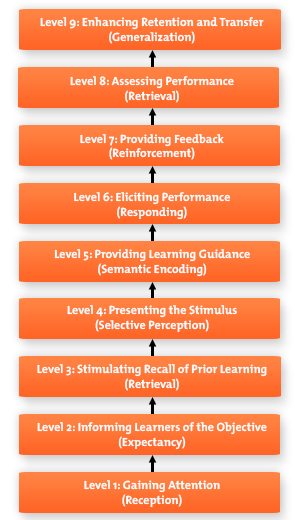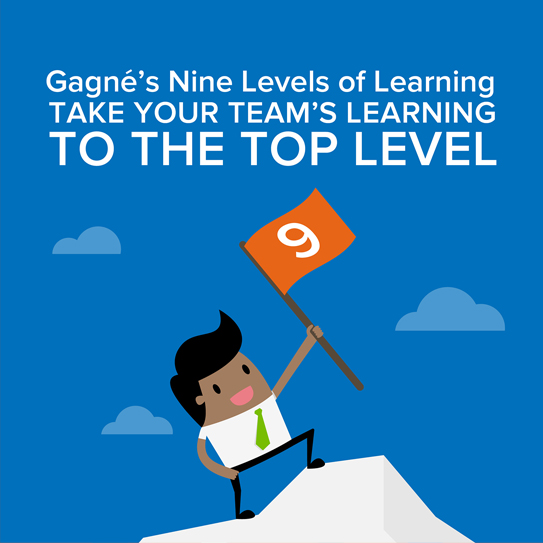Gagne's Nine Levels of Learning
Training Your Team Effectively

© Veer
Elina Manninen
Use Gagne's Nine Levels to structure and deliver effective training.
Have you ever trained someone on a new process or skill? Perhaps you thought it would be an easy, straightforward task. But once you actually started the session, it may have been harder than you expected.
Everyone has different learning styles. So, how do you present information so that the trainee, or group of trainees, is learning effectively? And when is it appropriate to offer feedback, or ask for a demonstration of skills, to ensure that trainees understand your message?
Gagne's Nine Levels of Learning provide a step-by-step approach that can help managers, trainers, and facilitators structure their training so that their students or teams get the most from their learning opportunities.
In this article and infographic, we'll examine Gagne's Nine Levels of Learning, and we'll review how to apply this tool when training your team.
Note:
Gagne's Nine Levels of Learning are also known as Gagne's Nine Conditions of Learning, Gagne's Taxonomy of Learning, and Gagne's Nine Events of Instruction.
Background to Gagne's Nine Levels
Robert Gagne (1916–2002) was an educational psychologist who pioneered the science of instruction in the 1940s. His book "The Conditions of Learning," first published in 1965, identified the mental conditions that are necessary for effective learning.
Gagne created a nine-step process that detailed each element required for effective learning. The model is useful for all types of learning, but this article focuses on applying it to training your team in a work environment. You can see these nine steps in figure 1, below. (We'll explore these in detail later in this article.)
Figure 1: Gagne's Nine Levels of Learning

© Reproduced with permission from Southwestern College Publishing.
Benefits of Gagne's Model
Gagne's Nine Levels of Learning model gives trainers and educators a checklist to use before they engage in teaching or training activities. Each step highlights a form of communication that aids the learning process. When each step is completed in turn, learners are much more likely to be engaged and to retain the information or skills that they're being taught.
If you use this approach before any type of training session or presentation, you'll remember how to structure your session so that your people get the best possible learning experience.
How to Use Gagne's Nine Levels of Learning
We'll now look at each of the nine levels, and provide an example of how you can apply each step in your own situation.
Level 1: Gaining Attention (Reception)
Start the learning experience by gaining the attention of your audience. This change in stimulus alerts the group that learning will soon take place.
Apply: Gain attention by raising the volume of your voice, gesturing, showing a short video on the topic of instruction, or using any other event that brings the period of "waiting for the lesson to start" to an end.
Level 2: Informing Learners of the Objective (Expectancy)
Next, you must ensure that your team knows what they need to learn, and that they understand why they're about to learn this new information.
Apply: Explain to your team what they will have learnt by the end of the session. Then, explain how their learning is going to benefit them, and the organization.
For example, you might explain that the new process that they're going to learn about will save the organization 20 percent in overhead fees. Because of recent budget cuts, the new lower-cost process will help your organization avoid laying six people off in your department. Now that your team understands why they're learning this new information, and what the risks are if they don't learn it, they'll be more motivated and more receptive to your training.
Level 3: Stimulating Recall of Prior Learning (Retrieval)
When your people learn something new, match the new information with related information or topics they've learned in the past.
Apply: Review any previous learning that you've done with your team, and apply it to what they're learning now. Also, ask your team if they have any previous experiences with the topic, or if they have experienced the problems that the training is trying to resolve. Then make connections between what they are learning, and their previous learning.
Level 4: Presenting the Stimulus (Selective Perception)
Present the new information to the group in an effective manner.
Apply: Organize your information in a logical and easy-to-understand manner. Try to use a variety of different media and styles (such as visual cues, verbal instruction, and active learning) to suit people with different learning styles.
Tip:
Step 2 of the Communication Cycle can help you to identify the best way to present your information.
Level 5: Providing Learning Guidance (Semantic Encoding)
To help your team learn and retain the information, provide alternative approaches that illustrate the information that you're trying to convey.
Apply: Help your team learn more effectively by including examples, case studies, graphics, storytelling, or analogies.
Level 6: Eliciting Performance (Responding)
At this stage, you need to ensure that your people can demonstrate their knowledge of what you've taught them. The way that they show this depends on what they're learning.
Apply: If you've taught a new process or skill, ask your people to demonstrate how to use it (role playing exercises can be useful for this). If you've taught new information, ask questions so that they can show their knowledge.
Level 7: Providing Feedback (Reinforcement)
After your team demonstrates their knowledge, provide feedback and reinforce any points as necessary.
Apply: Imagine that you've taught your team a new technique for handling difficult customers. After several role playing scenarios, you notice that a few team members aren't assertive enough to calm the customer in this fictional "tense situation." Your feedback and tips point out their mistakes so that they can correct them.
Level 8: Assessing Performance (Retrieval)
Your team should be able to complete a test, or other measurement tool, to show that they've learned the material or skill effectively. Team members should complete this test independently, without any help or coaching from you.
Apply: Tests, short questionnaires, or even essays can be good ways of testing your team's new knowledge.
Tip:
It may also be useful to provide further feedback after you have assessed their performance.
Level 9: Enhancing Retention and Transfer (Generalization)
In this last stage, your team members show that they've retained information by transferring their new knowledge or skill to situations that are different from the ones you've trained them on.
Apply: Repeated practice is the best way to ensure that people retain information and use it effectively. Make sure that your team has enough opportunity to use their learning on a regular basis. Schedule "practice runs" if you've been training on a new process, or have a follow-up session to review information or skills.
As people become more proficient, schedule in variants of the practice runs and expose people to different situations, so that they become comfortable generalizing.
Comparing With Other Training Models
Gagne's Nine Levels of Learning provide a useful approach that helps managers to structure the learning process. Each different stage complements the others, and by working through all nine levels, you can help to ensure that your team fully understands and retains information.
Although Gagne's model is different from other popular training models, you can still combine it with other methods. A good example is 4MAT, a training method that helps you to structure your approach so that people with different learning styles will learn just as effectively as everyone else. (Our article on 4MAT also explains common learning styles – Kolb's, and Honey and Mumford's are particularly respected.)
The ARCS model is also a good learning method to use with Gagne's model. ARCS focuses on motivation and making sure that learners understand the benefits of the new skill or information. Since this is step 2 in Gagne's model, the ARCS model can help you to understand better how to increase your team's motivation and engagement with the training.
Gagne's Nine Levels of Learning Infographic
Click on the image below to see Gagne's Nine Levels of Learning represented in an infographic:
Key Points
Gagne's Nine Levels of Learning provide a step-by-step checklist that you can use to design and present comprehensive and successful learning experiences. Each step is designed to help your trainees understand and retain information effectively.
The nine levels are:
- Gaining Attention (Reception).
- Informing Learners of the Objective (Expectancy).
- Stimulating Recall of Prior Learning (Retrieval).
- Presenting the Stimulus (Selective Perception).
- Providing Learning Guidance (Semantic Encoding).
- Eliciting Performance (Responding).
- Providing Feedback (Reinforcement).
- Assessing Performance (Retrieval).
- Enhancing Retention and Transfer (Generalization).
This site teaches you the skills you need for a happy and successful career; and this is just one of many tools and resources that you'll find here at Mind Tools. Subscribe to our free newsletter, or join the Mind Tools Club and really supercharge your career!







During lectures, the teacher will employ a variety of learning strategies such as mnemonics, concept mapping, role-playing, and visualizing to improve students' knowledge retention and comprehension.
Sometimes students require individualized attention because English is their second language or simply because they require a face-to-face meeting to understand the subject. In these cases, the instructor can offer a tutorial or make arrangements for a student contract.
We're glad that you found the article helpful. To cite this article, please visit our Permissions Helpdesk. You can access the Helpdesk here:
https://www.mindtools.com/community/Permissions
Good luck with your assignment.
Michele
Mind Tools Team